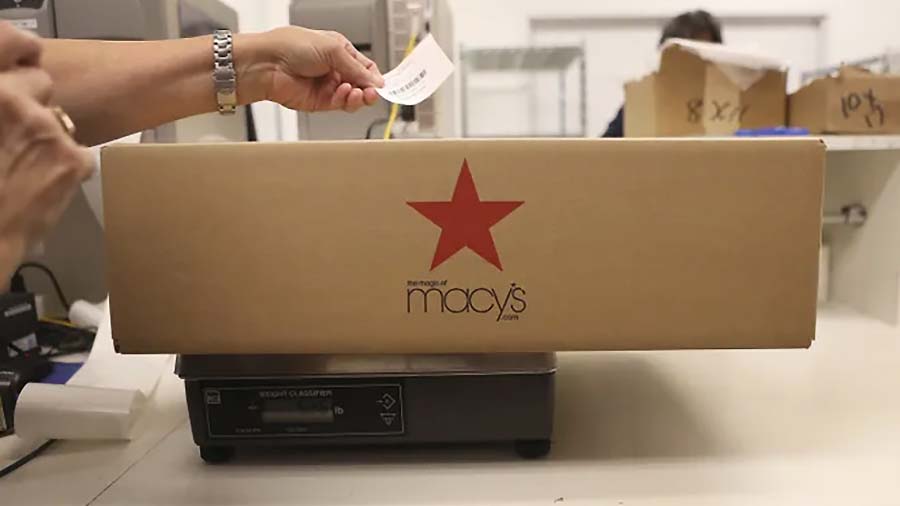Macy’s, Inc. remains cautious about ongoing macroeconomic pressures after reporting financial results for the second quarter and posting comp store sales declines at its Macy’s and Bloomingdale’s nameplates.
Consolidated net sales were $5.13 billion in the second quarter, down 8 percent versus the second quarter of 2022, with brick-and-mortar store sales decreasing 8 percent year-over-year (YoY) and digital sales decreasing 10 percent YoY.
- Consolidated comparable store sales were down 8.2 percent on an owned basis and down 7.3 percent on an owned-plus-licensed basis.
“In the second quarter, we delivered better-than-expected top and bottom-line results,” said Jeff Gennette, chairman and chief executive officer of Macy’s, Inc. “Our teams surgically implemented clearance markdowns and promotions to effectively clear spring seasonal receipts and ensure fresh assortments for the fall and Holiday seasons.”
Macy’s nameplate comp store sales were down 9.2 percent on an owned basis and down 8.2 percent on an owned-plus-licensed basis. The nameplate reportedly saw strength in beauty, particularly fragrances and prestige cosmetics, women’s career sportswear, and men’s tailored and off-price with Backstage, while active, casual and sleepwear remained challenged.
- The company said 41.5 million active customers shopped the Macy’s brand on a trailing twelve-month basis.
- Star Rewards program members made up approximately 72 percent of Macy’s brand comparable owned-plus-licensed sales on a trailing twelve-month basis, up approximately 3 percentage points versus the prior twelve-month period.
Bloomingdale’s comp store sales on an owned basis were down 2.7 percent and on an owned-plus-licensed basis were down 2.6 percent. The nameplate reportedly saw strength across beauty, women’s contemporary and designer apparel, shoes and outlet locations, while handbags, men’s and dresses were soft.
- The company said 4.0 million active customers shopped the Bloomingdale’s brand on a trailing twelve-month basis.
Bluemercury comparable sales were reportedly up 5.8 percent on an owned basis, with strength called out in skincare and color cosmetic categories during the quarter.
- The company said approximately 736,000 active customers shopped the Bluemercury brand on a trailing twelve-month basis.
Other revenue was tallied at $150 million, an $84 million decrease from the year-ago period. Other represented 2.9 percent of net sales in Q2, down from 4.2 percent in the prior-year period.
- The decline in the Other segment was said to be driven by credit card revenues which were negatively impacted by an increased rate of delinquencies across all stages of aged balances within the portfolio.
- While the company had expected delinquencies to rise as part of the normalizing credit environment, the speed at which the increase occurred for the company and the broader credit card industry since the company’s first-quarter earnings call was faster than expected. This negatively impacted second-quarter results and led to an increase in the portfolio’s bad debt outlook.
- Second quarter 2023 credit card revenues include the pro-rata recognition of the updated annual bad debt outlook.
Gross margin rate for the quarter was 38.1 percent of sales, down 80 basis points from 38.9 percent in the second quarter of 2022.
- Merchandise margin reportedly declined 130 basis points, due to heightened levels of clearance markdowns and promotions needed compared to the prior year to clear through spring seasonal products. Unfavorable category mix shifts and a shift in the timing of shortage recognition were said to be partially offset by better inbound freight charges from the company’s cost savings efforts. Shortage in the second quarter of 2023 was reportedly informed by a June physical inventory count in certain categories.
SG&A expense as a percent of total revenue was 37.5 percent in Q2, 300 basis points higher compared to the second quarter of 2022, reflecting the decline in sales year-over-year.
Macy’s reported a net loss of $22 million, or a loss of 8 cents per diluted share, in the second quarter, compared to net income of $275 million, or EPS of 99 cents, in the year-ago quarter.
Adjusted net income was $71 million, or 26 cents per diluted share, in Q2, compared to adjusted net income of $277 million, or diluted EPS of $1.00 a share, in the second quarter of 2022.
The diluted loss per share in the second quarter of 2023 includes a non-cash settlement charge related to the transfer of pension obligations for certain retirees and beneficiaries under the company’s pension plan.
Analysts had expectations of adjusted EPS of 14 cents on sales of $5.06 billion for the quarter, a Macy’s beat on both lines.
Merchandise inventories were reportedly down 10 percent year-over-year to $4.13 billion and down 18 percent to 2019, reflecting “ongoing disciplined inventory management and the clearance of excess spring seasonal product.”
- The company said it continues to focus on ensuring that merchandise inventories are current, contain compelling products, and are at the appropriate receipt levels based on expected sales demand.
- Inventory turnover, on a trailing twelve-month basis, was roughly flat to 2022 and up 15 percent to 2019.
“We continue to see uncertainty in the macroeconomic environment. We are leveraging our robust data science tools to refine inventory composition while reading and reacting to shifting consumer preferences to meet demand,” continued Gennette. “Looking ahead, we are committed to fortifying our core business and improving our customer experience while investing in our five growth vectors. We believe these advancements, enabled by our strong talent, will drive our relevancy and long-term success as a modern department store.”
2023 Guidance
In light of the “ongoing macroeconomic pressures and uncertainty on when those will abate,” the company said it continues to take a cautious approach to the consumer. The company is reaffirming its annual sales and earnings outlook.
Better-than-expected second-quarter gross margin, SG&A and interest expense, and a lower annual share count are expected to fully offset reduced annual credit card revenue and asset sale gain assumptions. The company’s annual shortage assumption has not materially changed from the prior outlook and remains elevated compared to recent historical levels.
Consistent with the company’s prior outlook, its earnings outlook includes the benefit of an incremental $200 million of cost savings identified as part of ongoing expense management that is favorably expected to impact both gross margin and SG&A expense. The full updated outlook for 2023, presented on a 53-week basis unless otherwise noted, can be found here.
Photo courtesy Macy’s
















